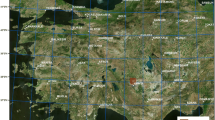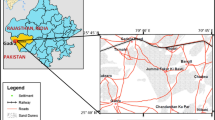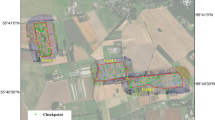Abstract
The aim of this paper is to assess co-registration errors in remote imagery through the AUGEO system, which consists of geo-referenced coloured tarps acting as terrestrial targets (TT), captured in the imagery and semi-automatically recognised by AUGEO2.0® software. This works as an add-on of ENVI® for image co-registration. To validate AUGEO, TT were placed in the ground, and remote images from satellite Quick Bird (QB), airplanes and unmanned aerial vehicles (UAV) were taken at several locations in Andalusia (southern Spain) in 2008 and 2009. Any geo-referencing system tested showed some error in comparison with the Differential Global Positioning System (DGPS)-geo-referenced verification targets. Generally, the AUGEO system provided higher geo-referencing accuracy than the other systems tried. The root mean square errors (RMSE) from the panchromatic and multi-spectral QB images were around 8 and 9 m, respectively and, once co-registered by AUGEO, they were about 1.5 and 2.5 m, for the same images. Overlapping the QB-AUGEO-geo-referenced image and the National Geographic Information System (NGIS) produced a RMSE of 6.5 m, which is hardly acceptable for precision agriculture. The AUGEO system efficiently geo-referenced farm airborne images with a mean accuracy of about 0.5–1.5 m, and the UAV images showed a mean accuracy of 1.0–4.0 m. The geo-referencing accuracy of an image refers to its consistency despite changes in its spatial resolution. A higher number of TT used in the geo-referencing process leads to a lower obtained RMSE. For example, for an image of 80 ha, about 10 and 17 TT were needed to get a RMSE less than about 2 and 1 m. Similarly, with the same number of TT, accuracy was higher for smaller plots as compared to larger plots. Precision agriculture requires high spatial resolution images (i.e., <1.5 m pixel−1), accurately geo-referenced (errors <1–2 m). With the current DGPS technology, satellite and airplane images hardly meet this geo-referencing requirement; consequently, additional co-registration effort is needed. This can be achieved using geo-referenced TT and AUGEO, mainly in areas where no notable hard points are available.




Similar content being viewed by others
References
Blackmore, S. (1996). An information system for precision farming. In Brighton conference on pests and diseases, British Crop Protection Council, Alton, UK (Vol. 3, pp. 1207–1214).
Borkowski, A., & Meier, S. (1994). A procedure for estimating the grid cell size of digital terrain models derived from topographic maps. Geo-Information-System, 7(1), 2–5.
DEM-Andalusia. (2005). Digital elevation model of Andalusia, Southern Spain. Government of Andalusia, Seville, Spain, Department of Environment. ISBN: 84-96329-34-8. Depósito Legal: M-31768-2005.
DIGITAL GLOBE Corp. (2010). A worldwide satellite provider company. Longmont, CO: DIGITAL GLOBE Corp. Accessed 23 April 2011, from http://www.digitalglobe.com/index.php/5/Welcome+to+DigitalGlobe.
ERDAS Inc. (1999). RMS error. In ERDAS field guide (5th ed., pp. 362–365). Atlanta, GA: ERDAS Inc.
García-Torres, L., Gómez-Candón, D., Peña-Barragán, J. M., Caballero Novella, J. J., López-Granados, F., & Jurado-Expósito, M. (2010). AUGEO-2.0 ® a software for the automatic geo-referencing of remote images. Madrid: Official Registration, Notary Public.
García-Torres, L., Peña-Barragán, J. M., López-Granados, F., Jurado-Expósito, M., & Fernández-Escobar, R. (2008). Automatic assessment of agro-environmental indicators from remotely sensed images of tree orchards and its evaluation using olive plantations. Computers and Electronics in Agriculture, 61, 179–191.
Hughes, M. L., McDowell, P. F., & Marcus, W. A. (2006). Accuracy assessment of georectified aerial photographs: Implications for measuring lateral channel movement in a GIS. Geomorphology, 74, 1–16.
Kienzle, S. (2004). The effect of DEM raster resolution on first order, second order and compound terrain derivatives. Transactions in GIS, 8(1), 83–112.
Kornus, W., & Ruiz, A. (2003). Strip adjustment of LIDAR data. In 3-D reconstruction from airborne laserscanner and InSAR data (pp. 47–50). Wageningen: Institute of Photogrammetry and Remote Sensing, GITC.
Kropff, M. J., Wallinga, J., & Lotz, L. A. P. (1997). Crop–weed interactions and weed population dynamics: Current knowledge and new research targets. In G. Skrzypczak, et al. (Eds.), Proceedings of the 10th symposium of the European Weed Research Society (EWRS), Poznan, Poland, 22–26 June 1997 (pp. 41–48).
López-Granados, F., Jurado-Expósito, M., Peña-Barragán, J. M., & García-Torres, L. (2006). Using remote sensing for identification of late-season grass weed patches in wheat. Weed Science, 54, 346–353.
NGIS. (2010). Spanish Ministry of Environment, Rural and Marine, Geographic Information System. Madrid: NGIS. Accessed 23 April 2011, from http://www.marm.es/es/agricultura/temas/sistema-de-informacion-geografica-de-parcelas-agricolas-sigpac-/ (in Spanish).
Pagnutti, M., Holekamp, K., Ryan, R., Blonski, S., Sellers, R., Davis, B., & Zanoni, V. (2002). Measurement sets and sites commonly used for characterizations. In S. Morain & A. Budge (Eds.), Proceedings of ISPRS commission I meeting, Denver (6 pp.), November 2002. Available on CD.
Peña-Barragán, J. M., Jurado-Expósito, M., López-Granados, F., Atenciano, S., Sánchez de la Orden, M., García-Ferrer, A., et al. (2004). Assessing land uses in olive groves from aerial photographs. Agriculture, Ecosystems & Environment, 103, 117–122.
Peña-Barragán, J. M., López-Granados, F., García-Torres, L., & Jurado-Expósito, M. (2009). Sunflower yield related to multitemporal aerial photography, land elevation and weed infestation. Precision Agriculture, 11(5), 568–585.
Peña-Barragán, J. M., López-Granados, F., García-Torres, L., Jurado-Expósito, M., Sánchez de la Orden, M., & García-Ferrer, A. (2008). Discriminating cropping systems and agri-environmental measures by remote sensing. Agronomy for Sustainable Development, 28, 355–362.
Peña-Barragán, J. M., López-Granados, F., Jurado-Expósito, M., & García-Torres, L. (2007). Mapping Ridolfia segetum patches in sunflower crop using remote sensing. Weed Research, 47, 164–172.
QUANTALAB-IAS. (2010). Laboratory for Research Methods in Quantitative Remote Sensing, Institute for Sustainable Agriculture, CSIC, Spain. Accessed 23 April 2011, from http://quantalab.ias.csic.es/.
Rydberg, A., Hagner, O., Söderström, M., & Börjesson, T. (2007). Field specific overview of crops using UAV (unmanned aerial vehicle). In J. V. Stafford (Ed.), Proceedings of the 6th European conference on precision agriculture (pp. 357–364). Wageningen: Wageningen Academic Publishers.
Schowengerdt, R. A. (2007). Topographic distortion. In Remote sensing: Models and methods for image processing (3rd ed., pp. 121–124). New York: Academic Press.
Slama, C. C., Theurer, C., & Henriksen, S. W. (1980). Manual of photogrammetry (4th ed.). Bethesda, MD: The American Society for Photogrammetry and Remote Sensing.
STEREOCARTO. (2010). Airplane fleet company for remote sensing. Madrid: STEREOCARTO. Accessed 23 April 2011, from http://www.stereocarto.com/en/productos/producto.php?id=43 (in Spanish).
Sui, R., Thomasson, J. A., Hanks, J., & Wooten, J. (2008). Ground-based sensing system for weed mapping in cotton. Computers and Electronics in Agriculture, 60(1), 31–38.
Toutin, T. H., & Chénier, R. (2004). GCP requirement for high resolution satellite mapping. In: Proceedings of the international society for photogrammetry and remote sensing congress, Istanbul, Turkey (Vol. 35, No. 3, pp. 836–839).
UAV. (2010). Development of unmanned aerial vehicles. Accessed 23 April 2011, from http://www.micropilot.com/; http://www.uavnavigation.com/; http://www.theuav.com/.
Weber, K. T., Théau, J., & Serr, K. (2008). Effect of co-registration error on patchy target detection using high-resolution imagery. Remote Sensing of Environment, 112, 845–850.
Acknowledgments
This research was partially financed by the Spanish Ministry of Science and Innovation through the projects AGL2007-60926 and AGL2010-15506.
Author information
Authors and Affiliations
Corresponding author
Rights and permissions
About this article
Cite this article
Gómez-Candón, D., López-Granados, F., Caballero-Novella, J.J. et al. Geo-referencing remote images for precision agriculture using artificial terrestrial targets. Precision Agric 12, 876–891 (2011). https://doi.org/10.1007/s11119-011-9228-3
Published:
Issue Date:
DOI: https://doi.org/10.1007/s11119-011-9228-3




